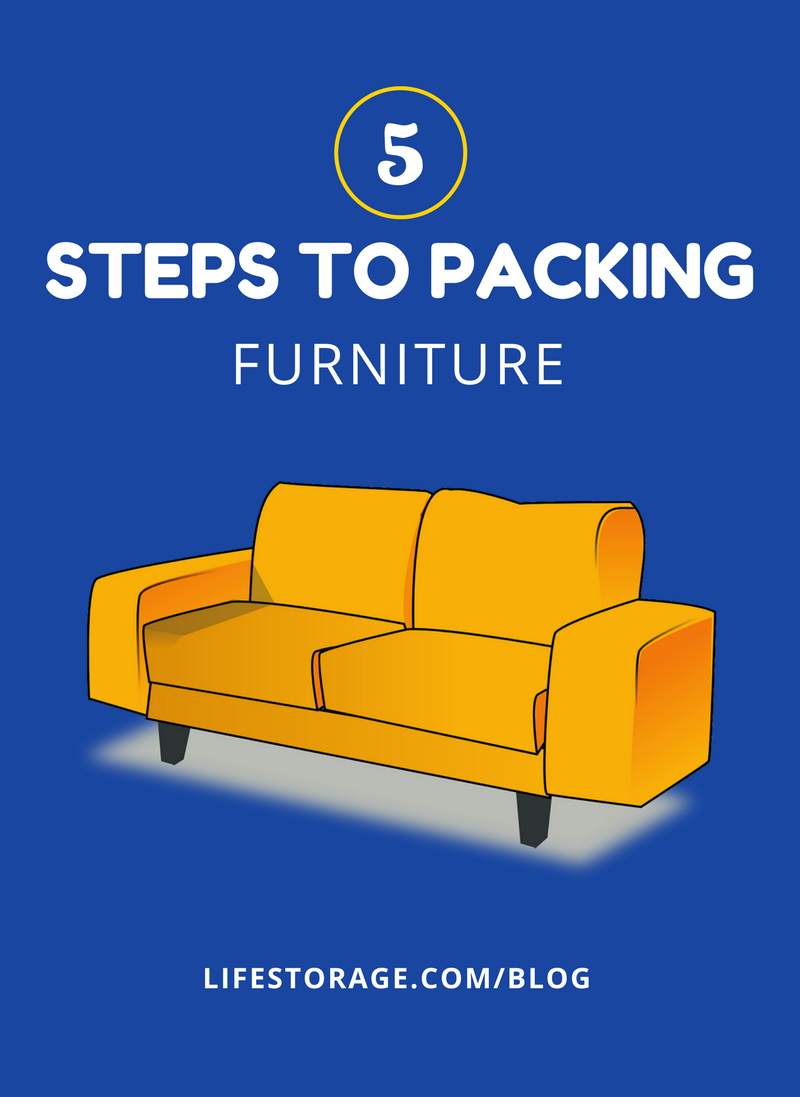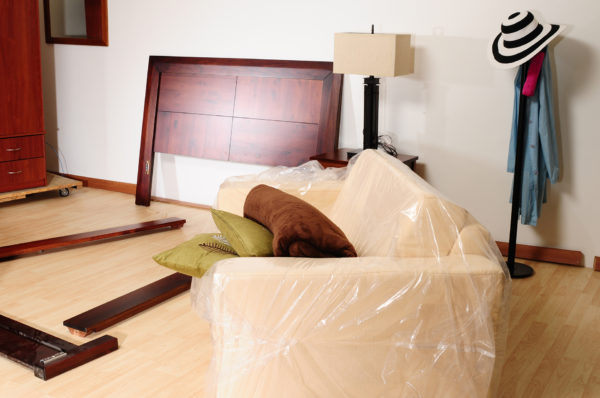Protect Your Furniture During the Moving Process
Updated 11/30/22 and 3/25/17 from an article originally published 5/18/2013.

Your furniture should always be handled with care, especially during a move. Whether you’re moving across the country or down the street, you want all your belongings to be damage-free when you arrive. Plus, furniture tends to be among the heaviest and most expensive items to pack, transport, and relocate. Damaged furniture pieces of any kind during the moving process can be exceptionally costly to replace.
Without the proper precautions, wood furniture can get gouged, upholstery can be ripped, and glass can break. In other words: Moving furniture without taking any protective measures can be complete and utter chaos. Luckily, you can move even your most fragile furniture without worrying about potential damage with a few supplies and some easy tricks.
Need to know the best way to move a single couch or dresser? Want to protect your furniture while it’s temporarily in storage? Maybe you’re moving into the brand-new house of your dreams and want to take all your favorite furniture pieces with you. Whatever your situation may be, we’ve got you covered.
Related: Is it Cheaper to Ship Furniture or Buy New When Relocating?
Learn how to protect your furniture when moving with our complete guide below. These packing tips will help you preserve every piece of furniture you own during every phase of your move.
Gather Packing Supplies

Be honest: In previous moves, have you packed all of your belongings into cardboard boxes and called it a day? How about loading your couch, dresser, or refrigerator straight into a moving truck without any wrapping or protection?
It’s a common moving myth that all you need to pack and protect your belongings are cardboard boxes, packing tape, and moving blankets. While these items will work, investing in a few more supplies will ensure your move to a new home or relocation to a storage facility is flawless.
What supplies do I need to protect furniture when moving?
If you want to protect your furniture during the moving process, you don’t need to spend much money on supplies. Simply head to your local hardware store or shop online to purchase the following additional items for your furniture:
- Bubble Wrap
- Sofa and mattress covers
- Plastic stretch wrap
- Sealable plastic bags
- Corrugated cardboard sheets
- Soft, non-scratch moving blankets
- Optional: Painters tape and a permanent marker for labeling
How to Prep Furniture for Packing
When it comes to larger pieces of furniture, we all know that disassembling is inevitable. But before you start taking drawers out of dressers and legs off of tables, there are a few key steps to take to prepare your furniture to be packed.
Before you pack or dismantle anything, take the time to thoroughly clean and dust your furniture. It may seem silly, but this is an important step. Dust and other debris can scratch hard surfaces during the moving process. Cleaning the furniture before you move also means you won’t drag any unnecessary grime into your new home. In other words: You’ll thank yourself later!
You’ll also want to take a few minutes to remove any knobs, casters, or pulls from your furniture. Take the drawers out of dressers and desks and pack other items neatly inside them. This functions as extra storage space while lightening up heavy furniture for the move.
Related: How to Pack a TV for Moving in 5 Easy Steps
Disassemble Furniture in Advance

Whenever possible, take your furniture completely apart. Remove the legs from tables and couches. Tear down your bed frame and remove cushions from sofas and chairs. In short, if a piece of furniture can be safely dismantled, do it. This will make the furniture easier to move and help prevent damage caused by brushing up against walls or door frames. It will also make it easier to pack your moving truck.
To safely dismantle furniture for packing, keep the following tips in mind:
● Always use an owner’s manual, if available, to determine how to take apart furniture, appliances, or electronics correctly.
● Use sealable plastic bags to hold the screws and other hardware for each piece of furniture. Tape the bag securely to the item to prevent losing any hardware.
● If a piece of furniture has a lot of pieces, use masking tape and a marker to note where each piece goes. This will go a long way to protect your furniture. (Not only does this protect your furniture in the long run, but it saves you time and effort when it’s time to put everything back together again.)
● Go easy with the drill when dismantling and reassembling. You don’t want to risk stripping the screws. Make sure you lower the torque setting and use the correct size drill bit for the job.
● Consider dismantling furniture the day before to save time on moving day. If you’re hiring movers, chances are you’re paying by the hour.
Should I shrink-wrap my furniture for moving?
When it comes to protecting your furniture, bubble wrap and plastic sheeting are fantastic tools that are easy to obtain. Plastic wrap adds an extra layer of protection and helps prevent gouges or scratches while furniture is on the moving truck.
How do you shrink-wrap furniture for moving?
Wrapping your furniture with bubble wrap or plastic sheets is incredibly easy. It’s totally doable to wrap furniture for moving by yourself. However, having a partner can help if the item is especially heavy or breakable. All you need to do is wrap delicate pieces in two to three layers. Plastic wrap, or specially designed plastic sofa covers, should be used to protect your upholstered items. In a pinch, old blankets or packing blankets will also work.
Bubble Wrap is also ideal for protecting glass table tops and mirrors. Consider taping a giant “X” on the item using painter’s tape, so if it breaks, it will be less likely to shatter. Wrap the glass or mirror completely, paying special attention to the corners. Finish by placing the item between two sheets of corrugated cardboard.
Does plastic wrap damage wood furniture?
Wood furniture is some of the easiest furniture to damage when moving. From antique wooden pieces to newly finished wood dressers and tables, it’s essential to protect these pieces adequately during a big move to preserve them for years to come.
However, if you’re planning on moving any wood furniture, plastic wrap and bubble wrap may not be the best protective option. Plastic wrap won’t damage wood furniture in any way, but it also may not provide enough protection to prevent warps, dents, and cracks. Instead, you may want to opt for something with a thicker material, like a moving blanket. Then, you can use plastic or bubble wrap as an additional layer of protection. Using corrugated cardboard sheets between wooden pieces is also a good idea.
For more information on wood furniture, check out this guide on How to Wrap & Pack Wood Furniture.
Learn How to Pack a Moving Truck
Once you’ve taken the time to prepare and wrap your furniture for the move, it’s time to load everything into your car, van, or moving truck. But did you know: The way you place your items in the moving truck makes a difference!
Related: Everything You Need to Know About Moving Boxes
Packing the moving truck tightly will ensure that your furniture items don’t get scuffed or fall on each other in transit. Plus, weight distribution is key to preventing damage along the way. For example, you want to avoid weight lying on top of a TV screen. This can lead to scratches, cracks, and irreversible damage.
Planning out how you’ll pack your moving truck will make things easier for you and your movers. Here are some of our best tips to help you get started:
● Start out by creating a wall of boxes across the backend of the truck. Boxes should be the same size, sealed, and tightly packed to prevent slipping. Choose your heaviest boxes, which shouldn’t contain fragile items, for this section. It will bring added stability.
● Next, move in any square furniture, such as dressers or desks. Place them directly against your box wall for added cushion. Be sure to use packing blankets or corrugated cardboard between pieces.
● Use the tops of the dressers to stack more boxes. Just be sure the boxes are lightweight and tightly packed to prevent slippage.
● Move in mattresses next. Place a blanket on the floor to protect your mattress from dirt, especially if you haven’t wrapped it.
● Upholstered items need additional care. Use rope to secure the pieces to the hooks in the truck. Then, carefully choose which items will be packed around them. Even though you’ve wrapped your upholstered items, include a layer of packing blankets for added security.
● Don’t forget to take care when unloading the truck as well. Make sure the path to each room is clearly marked for the movers. The less time spent finding the correct spot to put down your heavy furniture, the less likely it will become damaged.
Related: How to Thrift Furniture for Your New Home
Protect Your Furniture During the Moving Process
Moving doesn’t have to be stressful. Take some of the worry out of the equation by packing, securing, and moving your larger items properly. Doing so will help ensure your furniture arrives at your new home in good shape. If you decide to utilize self storage for your move, learn more about how to keep your items safe inside a storage unit.
